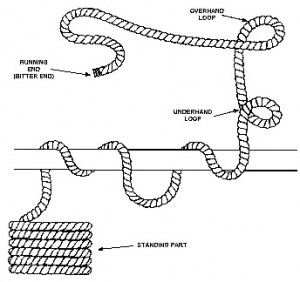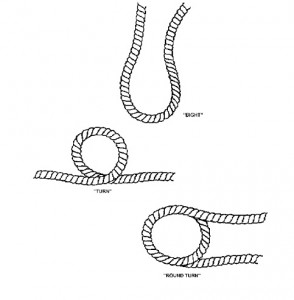Safe Boat Operations – Knot Tying – Terminology
Source: Mariners Learning System, By Captain Bob Figular
Knots are used for pulling, holding, lifting, and lowering. When using line for these purposes, it is often necessary to join two or more lines together. Knots and bends are used for temporary joining, and splices provide a permanent joining. In either case, the breaking strength (BS) of the joined line is normally less than the BS of the separated lines. The weakest point in a line is the knot or splice. They can reduce the breaking strength of a line as much as 50 to 60 percent.
Knots are the intertwining of the parts of one or more lines to secure the lines to themselves, each other (bends), or other objects (hitches). Because knots decrease the strength of the line, they should always be treated as temporary. If something permanent is needed, a splice or seizing can be used.
- The running end (bitter end) is the end of the line that is worked with.
- The standing part is the long unused or belayed end of a line. It is the remaining part of the line, including the end that is not worked.
- The overhand loop is a loop made in a line by crossing the bitter end over the standing part.
- The underhand loop is a loop made in the line by crossing the bitter end under the standing part.
- A bight is a half loop formed by turning the line back on itself.
- A turn is a single wind or bight of a rope, laid around a belaying pin, post, bollard, or the like.
- A round turn is a complete turn or encircling of a line about an object, as opposed to a single turn.

